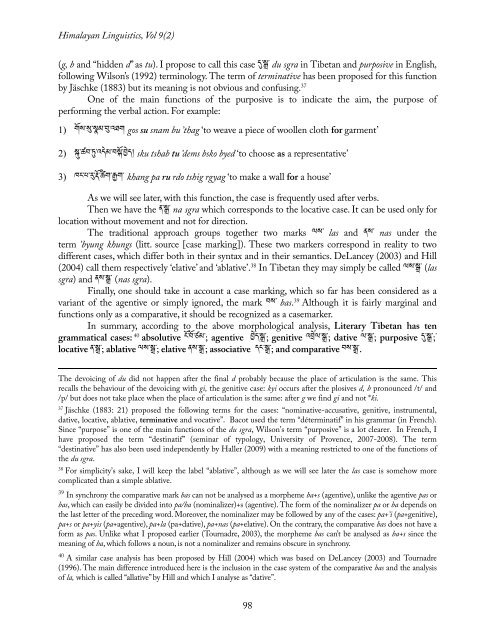The Classical Tibetan cases and their transcategoriality
The Classical Tibetan cases and their transcategoriality
The Classical Tibetan cases and their transcategoriality
Create successful ePaper yourself
Turn your PDF publications into a flip-book with our unique Google optimized e-Paper software.
Himalayan Linguistics, Vol 9(2)<br />
(g, b <strong>and</strong> “hidden d” as tu). I propose to call this case དུ་སྒྲ་ du sgra in <strong>Tibetan</strong> <strong>and</strong> purposive in English,<br />
following Wilson’s (1992) terminology. <strong>The</strong> term of terminative has been proposed for this function<br />
by Jäschke (1883) but its meaning is not obvious <strong>and</strong> confusing. 37<br />
One of the main functions of the purposive is to indicate the aim, the purpose of<br />
performing the verbal action. For example:<br />
1) གོས་སུ་སྣམ་བུ་འཐག gos su snam bu ’thag ‘to weave a piece of woollen cloth for garment’<br />
2) སྐུ་ཚབ་ཏུ་འདེམ་བསྐོ་བྱེད། sku tshab tu ’dems bsko byed ‘to choose as a representative’<br />
3) ཁང་པ་རུ་རྡོ་ཚིག་རྒྱག་ khang pa ru rdo tshig rgyag ‘to make a wall for a house’<br />
As we will see later, with this function, the case is frequently used after verbs.<br />
<strong>The</strong>n we have the ན་སྒྲ་ na sgra which corresponds to the locative case. It can be used only for<br />
location without movement <strong>and</strong> not for direction.<br />
<strong>The</strong> traditional approach groups together two marks ལས་ las <strong>and</strong> ནས་ nas under the<br />
term ’byung khungs (litt. source [case marking]). <strong>The</strong>se two markers correspond in reality to two<br />
different <strong>cases</strong>, which differ both in <strong>their</strong> syntax <strong>and</strong> in <strong>their</strong> semantics. DeLancey (2003) <strong>and</strong> Hill<br />
(2004) call them respectively ‘elative’ <strong>and</strong> ‘ablative’. 38 In <strong>Tibetan</strong> they may simply be called ལས་སྒྲ་ (las<br />
sgra) <strong>and</strong> ནས་སྒྲ་ (nas sgra).<br />
Finally, one should take in account a case marking, which so far has been considered as a<br />
variant of the agentive or simply ignored, the mark བས་ bas. 39 Although it is fairly marginal <strong>and</strong><br />
functions only as a comparative, it should be recognized as a casemarker.<br />
In summary, according to the above morphological analysis, Literary <strong>Tibetan</strong> has ten<br />
grammatical <strong>cases</strong>: 40 absolutive ངོ་བོ་ཙམ་; agentive བྱེད་སྒྲ་; genitive འབྲེལ་སྒྲ་; dative ལ་སྒྲ་; purposive དུ་སྒྲ་;་<br />
locative ན་སྒྲ་; ablative ལས་སྒྲ་; elative ནས་སྒྲ་; associative དང་སྒྲ་; <strong>and</strong> comparative བས་སྒྲ་.<br />
<strong>The</strong> devoicing of du did not happen after the final d probably because the place of articulation is the same. This<br />
recalls the behaviour of the devoicing with gi, the genitive case: kyi occurs after the plosives d, b pronounced /t/ <strong>and</strong><br />
/p/ but does not take place when the place of articulation is the same: after g we find gi <strong>and</strong> not *ki.<br />
37 Jäschke (1883: 21) proposed the following terms for the <strong>cases</strong>: “nominative-accusative, genitive, instrumental,<br />
dative, locative, ablative, terminative <strong>and</strong> vocative”. Bacot used the term “déterminatif” in his grammar (in French).<br />
Since “purpose” is one of the main functions of the du sgra, Wilson’s term “purposive” is a lot clearer. In French, I<br />
have proposed the term “destinatif” (seminar of typology, University of Provence, 2007-2008). <strong>The</strong> term<br />
“destinative” has also been used independently by Haller (2009) with a meaning restricted to one of the functions of<br />
the du sgra.<br />
38 For simplicity’s sake, I will keep the label “ablative”, although as we will see later the las case is somehow more<br />
complicated than a simple ablative.<br />
39 In synchrony the comparative mark bas can not be analysed as a morpheme ba+s (agentive), unlike the agentive pas or<br />
bas, which can easily be divided into pa/ba (nominalizer)+s (agentive). <strong>The</strong> form of the nominalizer pa or ba depends on<br />
the last letter of the preceding word. Moreover, the nominalizer may be followed by any of the <strong>cases</strong>: pa+’i (pa+genitive),<br />
pa+s or pa+yis (pa+agentive), pa+la (pa+dative), pa+nas (pa+elative). On the contrary, the comparative bas does not have a<br />
form as pas. Unlike what I proposed earlier (Tournadre, 2003), the morpheme bas can’t be analysed as ba+s since the<br />
meaning of ba, which follows a noun, is not a nominalizer <strong>and</strong> remains obscure in synchrony.<br />
40 A similar case analysis has been proposed by Hill (2004) which was based on DeLancey (2003) <strong>and</strong> Tournadre<br />
(1996). <strong>The</strong> main difference introduced here is the inclusion in the case system of the comparative bas <strong>and</strong> the analysis<br />
of la, which is called “allative” by Hill <strong>and</strong> which I analyse as “dative”.<br />
98
















